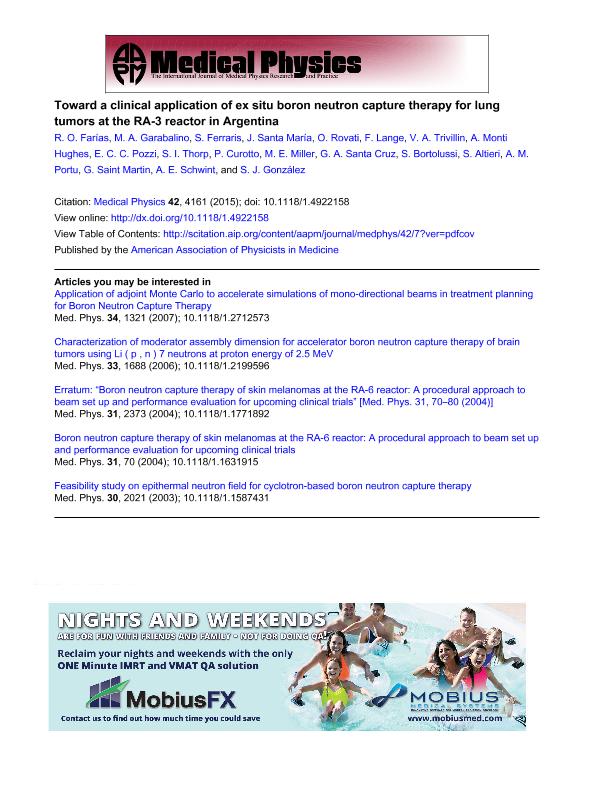Artículo
Toward a clinical application of ex situ boron neutron capture therapy for lung tumors at the RA-3 reactor in Argentina
Farías, Rubén Oscar ; Garabalino, Marcela Alejandra; Ferraris, Sergio; Santa María, Juan; Rovati, Osvaldo Daniel; Lange, Fernando; Trivillin, Verónica Andrea
; Garabalino, Marcela Alejandra; Ferraris, Sergio; Santa María, Juan; Rovati, Osvaldo Daniel; Lange, Fernando; Trivillin, Verónica Andrea ; Monti Hughes, Andrea
; Monti Hughes, Andrea ; Pozzi, Emiliano César Cayetano; Thorp, Silvia Inés; Curotto, Paula; Boltolussi, S.; Altieri, S.; Portu, Agustina Mariana
; Pozzi, Emiliano César Cayetano; Thorp, Silvia Inés; Curotto, Paula; Boltolussi, S.; Altieri, S.; Portu, Agustina Mariana ; Saint Martin, María Laura Gisela; Schwint, Amanda Elena
; Saint Martin, María Laura Gisela; Schwint, Amanda Elena ; González, Sara Josefina
; González, Sara Josefina
 ; Garabalino, Marcela Alejandra; Ferraris, Sergio; Santa María, Juan; Rovati, Osvaldo Daniel; Lange, Fernando; Trivillin, Verónica Andrea
; Garabalino, Marcela Alejandra; Ferraris, Sergio; Santa María, Juan; Rovati, Osvaldo Daniel; Lange, Fernando; Trivillin, Verónica Andrea ; Monti Hughes, Andrea
; Monti Hughes, Andrea ; Pozzi, Emiliano César Cayetano; Thorp, Silvia Inés; Curotto, Paula; Boltolussi, S.; Altieri, S.; Portu, Agustina Mariana
; Pozzi, Emiliano César Cayetano; Thorp, Silvia Inés; Curotto, Paula; Boltolussi, S.; Altieri, S.; Portu, Agustina Mariana ; Saint Martin, María Laura Gisela; Schwint, Amanda Elena
; Saint Martin, María Laura Gisela; Schwint, Amanda Elena ; González, Sara Josefina
; González, Sara Josefina
Fecha de publicación:
07/2015
Editorial:
Wiley
Revista:
Medical Physics
ISSN:
0094-2405
Idioma:
Inglés
Tipo de recurso:
Artículo publicado
Clasificación temática:
Resumen
Purpose: Many types of lung tumors have a very poor prognosis due to their spread in the whole organ volume. The fact that boron neutron capture therapy (BNCT) would allow for selective targeting of all the nodules regardless of their position, prompted a preclinical feasibility study of ex situ BNCT at the thermal neutron facility of RA‐3 reactor in the province of Buenos Aires, Argentina. (l)‐4p‐dihydroxy‐borylphenylalanine fructose complex (BPA‐F) biodistribution studies in an adult sheep model and computational dosimetry for a human explanted lung were performed to evaluate the feasibility and the therapeutic potential of ex situ BNCT. Methods: Two kinds of boron biodistribution studies were carried out in the healthy sheep: a set of pharmacokinetic studies without lung excision, and a set that consisted of evaluation of boron concentration in the explanted and perfused lung. In order to assess the feasibility of the clinical application of ex situ BNCT at RA‐3, a case of multiple lung metastases was analyzed. A detailed computational representation of the geometry of the lung was built based on a real collapsed human lung. Dosimetric calculations and dose limiting considerations were based on the experimental results from the adult sheep, and on the most suitable information published in the literature. In addition, a workable treatment plan was considered to assess the clinical application in a realistic scenario. Results: Concentration‐time profiles for the normal sheep showed that the boron kinetics in blood, lung, and skin would adequately represent the boron behavior and absolute uptake expected in human tissues. Results strongly suggest that the distribution of the boron compound is spatially homogeneous in the lung. A constant lung‐to‐blood ratio of 1.3 ± 0.1 was observed from 80 min after the end of BPA‐F infusion. The fact that this ratio remains constant during time would allow the blood boron concentration to be used as a surrogate and indirect quantification of the estimated value in the explanted healthy lung. The proposed preclinical animal model allowed for the study of the explanted lung. As expected, the boron concentration values fell as a result of the application of the preservation protocol required to preserve the lung function. The distribution of the boron concentration retention factor was obtained for healthy lung, with a mean value of 0.46 ± 0.14 consistent with that reported for metastatic colon carcinoma model in rat perfused lung. Considering the human lung model and suitable tumor control probability for lung cancer, a promising average fraction of controlled lesions higher than 85% was obtained even for a low tumor‐to‐normal boron concentration ratio of 2. Conclusions: This work reports for the first time data supporting the validity of the ovine model as an adequate human surrogate in terms of boron kinetics and uptake in clinically relevant tissues. Collectively, the results and analysis presented would strongly suggest that ex situ whole lung BNCT irradiation is a feasible and highly promising technique that could greatly contribute to the treatment of metastatic lung disease in those patients without extrapulmonary spread, increasing not only the expected overall survival but also the resulting quality of life.
Palabras clave:
Bnct
,
Ex Situ Irradiation
,
Lung Tumors
,
Bpa-F
,
Pharmacokinetics
Archivos asociados
Licencia
Identificadores
Colecciones
Articulos(SEDE CENTRAL)
Articulos de SEDE CENTRAL
Articulos de SEDE CENTRAL
Citación
Farías, Rubén Oscar; Garabalino, Marcela Alejandra; Ferraris, Sergio; Santa María, Juan; Rovati, Osvaldo Daniel; et al.; Toward a clinical application of ex situ boron neutron capture therapy for lung tumors at the RA-3 reactor in Argentina; Wiley; Medical Physics; 42; 7; 7-2015; 4161-4173
Compartir
Altmétricas



